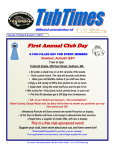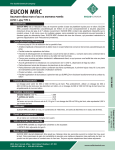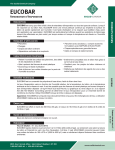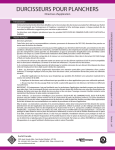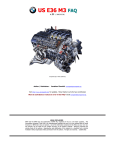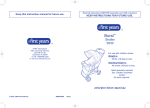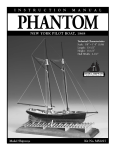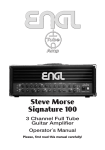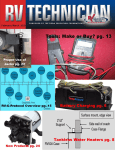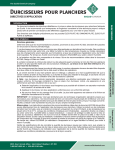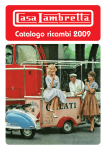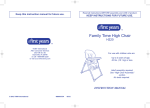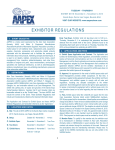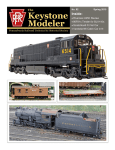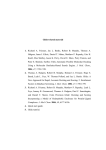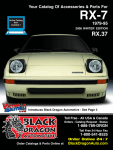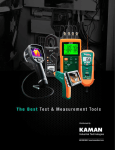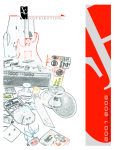Download C:\My Documents\56Golddocs\56j only bk\56JONLY.014
Transcript
56J ONLY THE PERIODIC NEWSLETTER OF THE 1956 STUDEBAKER GOLDEN HAWK OWNERS REGISTER NUMBER 014 ESTABLISHED JANUARY 1, 1989 I don't have any idea what all this means, but it was certainly confusing. Anyway, Bob seems happy with his wheel and that is all that matters. Some of the other places I wrote to were: 1 Bill Peters Restorations - Rockville Center, New York 2 Backwards Unlimited Poulsbo, Washington - (Jim Ellis) 3 Tom Schrock - Coalport, Pennsylvania 4 Professional Steering Wheel Restorations - Fallbrook, California 5 Benjamin Steering Wheel - Monroe, Washington (Mike Benjamin) 6 Steering Wheel Restoration Cleveland, Georgia (Jack Turpin, Jr.) 7 Antique Steering Wheel - Costa Mesa, California (James Erickson) PURE AND SIMPLE On the next few pages, I will be presenting some restoration/update options which are available through services advertising in various old car publications. The ultimate decision is yours and will probably be based on the way you want to enjoy your 1956 Studebaker Golden Hawk. STEERING WHEEL UPDATE! Robert Palmer AUGUST 1992 Sarasota, Florida April 30, 1992 I'm enclosing an ad out of Hemmings Motor News. My steering wheel was in deplorable condition so I took it up to Seffner (Fl.) and had them restore it. They did a wonderful job, even to color. They stripped it down to the steel core and rebuilt it like new, including the color, (white). It was expensive, $375.00 but under the circumstances, what can you do? If I had only about 7 cracks in it, the price would have been $250.00. The complete address is: Automotive Specialties 11240 East Sligh Ave. Seffner, Florida 33584 1-800-676-1928 They offer a 3 year warranty and 3 week turnaround. In issue #013 I told you that I had sent my steering wheel to Algar G. Dole of W.W. Motorcars Inc. in Broadway, Virginia. The wheel was to be repaired and then used to make a casting. The casting would then be used to make a master mold. I used my wheel, which was in pretty good condition, because repeated requests for a new old stock wheel proved futile. The mold would be retained by Mr. Dole and would be used to recast my wheel and other 1956 Golden Hawk steering wheels. It is my pleasure to report that this phase has been completed and I am very happy with the results. It is expensive at $380.00 and certainly is not for everyone, but it does present one alternative to the steering wheel problem. Each of us has our own reasons for owning our car(s) and a price tag in this stratosphere may not be consistent with those reasons. You can get your steering wheel repaired somewhere else for less money. Thanks to Bob for the above information. In looking through my records, I found that in September 1990 I had written to Automotive Specialties, except that they were located in Wimauma, Florida. They had the same address and phone # as another place I had written to called Steering Wheel Classics. I also wrote to an Automotive Specialties in Gibsonton, Florida with the same phone # as the one in Wimauma. As stated above, I wrote to several advertisers and received a variety of answers. Most indicated prices in the 14-1 range of $125.00 to $300.00. The problem with "repairing" a wheel is that when completed, some part of the wheel will still consist of the old plastic. The quality of which is the very reason for having the wheel repaired in the first place. It may look good for a while, but won't the part that wasn't repaired continue to deteriorate? An article in the December 1991 issue of Classic Auto Restorer written by Tim Howley provided some history and insight into the business of "remanufacturing" plastic steering wheels. Two companies supplying information for the article were: The J. B. Donaldson Company 2533 W. Cypress Phoenix, Arizona 85009 602-278-4505 and Algar G. Dole c/o W W Motor Cars & Parts, Inc. 132 North Main Street Broadway, Va 22815 703-896-8243 The article explained how experts rebuild a wheel. The result is not a repaired wheel (one with the cracks filled in), but a remanufactured wheel with all new plastic. Part of the article follows: new mold. He said he would not charge me for the making of the mold. Below is a portion of the article describing Mr. Dole and his process: Unfortunately, I could not find a manufacturer who already had a mold for my wheel and I did not have an NOS steering wheel to send. I decided to take my chances using my old wheel. I wrote to both companies explaining our steering wheel situation. For whatever reason, the J. B. Donaldson Company did not respond, but I did receive an answer from Algar G. Dole. He did not have a mold for our steering wheel, but agreed to restore my wheel Algar G. Dole, of Broadway, Virginia is one manufacturer who remanufactures steering wheels for Chryslers, Packards and Lincolns as well as General Motors products. He also does deluxe steering wheels for the lesser makes, including the mottled wheels, plus wheels for midfifties and later GM luxury cars. All of his wheels, regardless of complexity, run around $400. While Dole does not state the composition of the plastic used, he calls it a mottled plastic resin and he doesn't know what temperature variations it will withstand, but he seems to have a wide following of satisfied customers, particularly among Lincoln Zephyr and Lincoln Continental owners. He states that he has had no complaints about his wheels. Dole makes all types of wheels, including the old synthetic rubber wheels. He will make up special wheels, such as those that had chrome plated rings in the wheel handle. He does a lot of accessory and sixties steering wheels, as well. Dole owns WW Motor Cars & Parts, a restoration shop. In 1984 he had a 1964 Olds convertible needing a steering wheel and many other plastic and rubber parts. Realizing that parts were practically impossible to find, he decided to mold them. This led to his business in plastic and molded rubber parts, which still caters very much to the Sixties collector car trade. Dole invested considerable time and money experimenting with molding techniques and plastics, eventually devising a process that worked out quite well. The color is matched to the original and is suspended throughout the plastic. Finally, the wheel is sealed in photo-resistant clear plastic to protect the pigment from ultraviolet rays. Many restorers say that there is no epoxy that will hold up for any length of time. Some owners have decided to simply fill in the cracks with epoxy and then paint the wheel to ivory or maroon or whatever color the wheel was originally. Cracks will probably reappear in time, but the customer isn't and make a mold from it. He would then chip all the plastic from my newly restored wheel and recast it using the spending $300 or $400. Dole used to repair steering wheels but decided to stop doing it, due to those cracking problems. Reproduction plastic steering wheels are now cast monolithically. Beginning with the old wheel, a casting is made, then a mold is made from the casting. There can be real problems bringing in an old wheel to a remanufacturer. The ring may not be perfect, or the plastic may have shrunk with age to the point where it is not perfectly round all the way around. It is best to go to a remanufacturer who already has a mold for a wheel exactly like yours. He will use your old wheel with its ring. 56J ONLY Page 14-2 56J ONLY The Lincoln Continental Owners Club had an article in the November-December 1989 issue of its newsletter, The Way of the Zephyr entitled Reproduction Steering Wheels from Algar G. Dole. Here is the text from that article. Since 1970, I have bought, driven, restored and sold several cars, but I always found that it was hard to get parts, especially plastic. In 1984 I purchased a 1954 Olds Starfire Convertible and had WW Motor Cars & Parts, Inc., a local restoration shop, begin restoration on it. We soon confirmed our belief that it would be almost impossible to locate plastic and rubber parts for this car. As I had an art background, WW Motor Cars began encouraging me to make my own parts, which I did, starting with some of the small parts. This led to making parts for WW Motors Cars which included steering wheels. As local requests for steering wheels arose, I invested more time and money, experimenting with moulding techniques and plastics, devising a process that worked very well. The color is matched to the original and is suspended throughout the plastic, not painted on. I then seal the wheel in a nonphotomechanical clear plastic to protect the pigment in the steering wheel from the sun's harmful rays. Not long after running ads in Hemmings Motor News, I started doing work for private individuals, as well as restoration shops such as Baywood, Batista, Sun Valley, etc. My technique, which allows for casting on your core, enables me to do both plastic and hard rubber steering wheels. I can cast clear, translucent, garnet, opaque or any combination. Steering wheel repair is $145.00 and I do reserve the right to refuse unrepairable wheels. Full wheel castings are $380.00 unless otherwise quoted, and shift knobs are $35.00. My turnaround time is generally four to six weeks. I pay for UPS, packaging and insurance back to you. Next-day air and two-day air is available at your request and expense. Well, that's the story on my 1956 Golden Hawk steering wheel. Although a NOS wheel would have been a better base to start with, I think it turned out very well. We now have a manufacturer who has a mold for our wheel. Anyone wishing to have his/her car's steering wheel recast can send the 56J ONLY wheel, along with a check in the amount of $380.00 to: Algar G Dole c/o WW Motor Cars & Parts, Inc. 132 Main st. Broadway, Va. 22815. 703-896-8243 FAX: 703-896-8244. Several of you have indicated that you have replaced your wheel with an incorrect one and disposed of your original. That is unfortunate as your original could have been saved. There may however still be some wheels possibly from other, pre 1957, C-K bodied cars which might use the same core. I spoke with WW Motor Cars & Parts owner, Jack Wenger, who said he could probably make the 4 little rings that go around the rim. He would have to add his cost (which he feels will be "nominal") to the price of the wheel but didn't know how much that would be until he actually did one. When you send your wheel, be sure to note that the wheel is for a 1956 Studebaker Golden Hawk. Do not send them an incorrect wheel unless you know for certain that the core is the same and you are willing to pay for the rings. If someone would like to give the J.B. Donaldson Company a try, it would be interesting to compare results. The cost to repair a wheel at his facility is $300.00 plus the cost of the plastic. Information from the article on Donaldson is presented below: Donaldson started casting steering wheels about 16 years ago. At that time there were a few people casting steering wheels, but they were using polyester resins (fiberglass), which weren't able to withstand thermal shock. The wheels he manufactures today can withstand a temperature range from -35° to +210°. The material is not a polyester; it is a material designed specifically to simulate the original Tenite (a product developed by Eastman Kodak) in texture, appearance and durability, but is considerably cheaper. Donaldson first strips the old plastic, paints the metal ring the appropriate color, and recasts the plastic, finally removing the finished wheel from the mold and hand-finishing it. Once the wheel is molded or cast, the flashing left as a result of the tooling is hand finished. It is very time consuming to make these wheels: most is spent on buffing and hand Page 14-3 56J ONLY finishing. He must start with a wheel that is a little too big and then sand it down to the correct diameter. He estimates that the average time involved in making a GM plastic wheel is about 13 hours. Donaldson believes his company is the largest of its kind in the world. (NOTE: Too bad he doesn't have someone there to answer the mail. Sorry, I couldn't resist.) THE LEATHERIQUE MYSTIQUE My first 1956 Golden Hawk had been sitting since 1968 when I purchased it in 1983. Although the car spent part of those 15 years in it's owner's garage, the interior was in sad shape because of so many years in the Florida sun. The dash board vinyl was cracked and the seats were so dry that the cushion material had to be replaced. The door panels were all dried out at the bottom and the cardboard backing was in shreds. The arm rests were cracked and the vinyl had fused to the plastic underneath, due to the heat. I wasn't able to save the seats, but I thought I'd like to see if the door panels could be spared. I saw an ad in Hemming's Motor News about a leather and vinyl restoration product called Leatherique. I haven't seen Leatherique ads for several years. The last time I purchased the product was in 1988. Originally, I purchased it from the Clausen Company in Fords, N. J. The last information I have is that it was owned by George C. Pavlisko. The address was Leatherique Restoration Products, 369 Blanding Blvd. Suite N-05, Orange Park, Florida 32073. A call to the phone # 904-276-2220 produced a message stating the number was no longer in service. They had a kit which consisted of a rejuvinator oil, solvent cleaner, paint brush, sand paper, crack filler, and the Leatherique which is a paint type product. I had to have my paint custom matched in light rose mist and dark rose mist to match the interior of my Mocha/Doeskin car. The cost of an 8 oz. can in standard colors was $13.00. The price rose to $30.25 for a color match. I had new backing put on the door panels and had the arm rests reconstructed and covered with white vinyl. I used white in place of the light rose mist because nobody on this planet had anything that would match the color I needed. 56J ONLY I used the products in the kit on my door panels and the rear panels per the instructions and was ready to paint. The color match (2 colors) was perfect and one coat covered all the scratches and the white vinyl arm rests. It even covered the primer which got on the bottom when the previous owner removed the carpet and painted the floor. The paint went a long way so I also painted the dash liner, kick panels, and the rear shelf. I even used it on my headliner. The brush cleaned up with water and I used it several times. The two main lessons I learned were to use a thin coat and to wait for it to dry before applying another coat. I was able to save my door panels and at a fraction of the cost of new vinyl, materials, and labor. If the panels ever become marred for some reason, I can just paint them again. The seats were too far gone and I would have been leery to paint them due to the nature of their use. However, I read an article about Leatherique written by Terry Boyce who used it on the seats of his project car and he gave a very good review. I know it seems silly to tell you about a product that apparently is no longer available, but I recently saw an ad for a product called Surflex. I sent for the free booklet and the information suggests the product is similar to Leatherique. A portion of the booklet dealing with refinishing vinyl is printed below: Unlike leather, which is a natural organic product, vinyl and other imitations are of chemical composition. Impregnated with plasticizers, they generally remain supple for quite a long time. When the plasticizers eventually migrate into the atmosphere, there is nothing that can be done to re-soften these materials. Surface blemishes such as rips or tears and holes can be repaired in the same manner as with leather, and they can be refinished! The surface should be thoroughly cleaned with a good detergent or solvent (that will not dissolve the vinyl) and it should be lightly sanded with either fine sandpaper or fine steel wool. Once prepared in this manner, the recoloring procedure is the same as for leather. Begin in an inconspicuous area such as a seat back or bottom and apply a Page 14-4 56J ONLY thin coat of "SURFLEX" Flexible Surface Colorant, concentrating on even application rather than good color coverage. Do not re-stroke partially dried areas to avoid leaving brush marks. As soon as the first coat is dry to the touch, a second coat, can be applied. If necessary, touch up with a third coat. Use varied brush strokes (half-circles, cross-hatches, etc.) to eliminate any brush mark patterns. Application of Surflex can also be done by spraying, however if it is anything like Leatherique, brushing provided excellent results. Leather is the intended use for both Leatherique and Surflex, but it can do some good on vinyl as well. A free booklet can be obtained by writing to: COLOR PLUS P. O. BOX 404 KEARNY, N.J. 07032 201-659-4708 If anyone tries Surflex, let me know how it works and I'll pass the information along. If it is anything like Leatherique, and it seems to be, it could present an alternative to a complete reupholstery job. MODERN "TACH"NOLOGY APT Specialists Inc. ran an ad in the May issue of Hemmings Motor News which stated they could convert Studebaker tachometers to modern circuitry. I sent for the information and received the following letter and information from President Charles E. Kulbeth. Thanks for the note about 1956 Golden Hawk. To convert a factory hawk tachometer to modern circuitry, it will cost $150.00 + S/H with a 1 year warranty. We do have some tachometers that are mechanical, $59.00 and electronic, $95.00, both of which could be converted to look like a Hawk tachometer. #1 To do the mechanical: we would have to change the dial, $50.00± and convert to electric, $150.00. #2 To do the electric after market tachometer, we would have to change the dial and recalibrate the circuitry. Dial $50.00±, calibrate $30.00, Tach $95.00. 56J ONLY 1 Mechanical convert 2 Electric convert $59.00 New Tach $95.00 New Tach $50.00 Dial Convert $50.00 Dial $125.00 to $150.00 $300.00 Calibrate $234.00 to $259.00 $175.00 + S/H We do offer quantity prices on repairs and parts. If you can find some Stewart Warner tachs, we could convert them to look like Hawk tachs too! Many of you have indicated a desire to locate a new tachometer and/or sending unit. We discussed tachometers in issue #006 and member Richard Poe of Cincinnati, Ohio provided information on a Stewart Warner tachometer model #82161 which looked like the one in our cars, but didn't require the distributor mounted sending unit (see issue #007). TAIL LIGHT HOUSINGS Over the past few years, many of you have asked about tail light housings. These have been difficult to find and very expensive when a search proved successful. The 1992 parts catalog from Ed Reynolds' Studebaker of California, which features member Robert Fitch's 1956 Golden Hawk on the front cover, lists tail light housings as available for $125.00 each side. I called owner Ed Reynolds to find out more. These are reproductions and I haven't seen what they look like. If anyone buys a pair, let me know how you like them and I will pass the word. I have seen a few NOS housings over the years in the $250 - $330 per pair range. You will have to make your own decision on the housings, but I think the catalog is a pretty good buy and lists quite a few 1956 Golden Hawk items. Catalogs can be purchased by sending $3.00 to: Studebaker of California 1400 Santa Fe Avenue Long Beach, California 90813 213-435-0157 FAX 213-436-3074 OIL PUMP SERVICE UPDATE Issue #013 contained a note from member Bob Edwards of Jacksonville, Florida. Bob reported talking to someone at Packards International who told him they no longer were providing the oil pump modification service. If you had procrastinated having this service done on your oil pump, I'm sure that this was disappointing news. I wrote to Packards International to see if they planned to continue the service at a later date. Page 14-5 56J ONLY I am happy to report that they "still offer this service." They included a catalog which explained the service and the new price of $125.00. See issue #007 for a description of the process and the address. Please note the price has changed from $100.00. Member Jim Lucas of Augusta, Kansas also called to inform me that Packards International was still providing this service. Jim also stated that he had previously purchased a rebuilt oil pump (not from Packards International) and after installing it in his car, the lifter noise returned in about a week or two. If your car has a problem with noisy valve lifters, even after they have been serviced, you might want to take advantage of this offer while it is available. I battled the problem for 6 years before this service corrected it. As far as I'm concerned, it was the difference between driving my car or letting it sit. (NOTE: The person responding to my letter (no name was included) indicated that we 1956 Golden Hawk owners would be accepted as members of Packards international.) Dennis Duke of Midland Texas also had some new information about the oil pump modification service. Here is what Dennis had to offer: "In regard to Bob Edwards' statement that Packards International no longer rebuilds and modifies the Packard oil pump, I have found that Terrill Machine Inc. does this modification. They will install new gears and will brush the shaft end and install a bushing in the gear end on a new thicker end plate for $100.00. I also found that Egge Machine in Santa Fe Spring, Ca. will grind my camshaft. They can also supply many engine parts. I thought this might help someone". The complete address is: DOOR PANEL MYLAR Member Pete Olmstead of Grandview, Washington stated that he believed the interior door panel mylar was gold, instead of silver, on Golden Hawks painted Ceramic Green/Snowcap White. He felt this may only be true of cars assembled at the Vernon (Los Angeles) plant. Member Jim Morgan of Merritt Island, Florida is the original owner of a Green/White Golden Hawk, South Bend serial #6030766. Jim states that he didn't think gold mylar was available in 1956 and that Studebaker simply painted the silver mylar. His car came with silver mylar which was painted gold. Portions of the gold paint wore off in about a year, revealing the silver finish underneath. He thinks all (Green/White?) 1956 Golden Hawks originally came with the gold painted mylar. We have several members who have owned their car since new, but I think Jim has the only green/white car. No one else has come forward with an answer to this question. POINTS TO PONDER I'll print the responses in the next issue. 1. 2. 3. How often should you change your oil and lubricate the chassis if you only drive your 56J less than 3000 miles a year? What type of insurance do you carry on your 56J and what type of driving (daily driver, showsparades-club functions only, etc.) do you do? What effect would it have if you removed that big coil spring, the one which plops into the hood catch plate, from the hood release mechanism? FROM THE MAILBAG Terrill Machine Inc. Rt 2 Box 61 DeLeon, Texas 76444 817-893-2610 (Letters are edited as required.) So now, instead of losing this service altogether, it appears we now have two choices. It is nice to be able to report some good news. THE FORUM This section presents some questions for you to think about and provides discussion on members' questions from previous issues. 56J ONLY BILL GLASS VALHALLA, NEW YORK April 20, 1992 We purchased those new window moulding strips to seal both front and rear windows. Neither fit properly and my front stainless trim suffered some heavy damage in the "glassier's" attempt Page 14-6 56J ONLY to install it. The rear window is in, but no trim could be installed. The reason is that the new rubber didn't fit properly. The garage owner asked me if the window expanded while it was out of the car. My wife told him the car shrank because I wet sanded it and as it dried, the water evaporated causing the car to shrink. I was commended on the paint job and the way I put her together, but I did screw up on a few little things which I caution other owners to watch for. Seems, according to Tony Caralla's grandson Wayne, even though a certain screw/bolt is called for, there are certain bolts/screws in Studebaker's design where the shoulders are different from those or any other automobile manufacturer. I had wondered why the car steered a little strange. It seems I had a lot of slop in the bolts holding the steering. Big word of caution to anyone flat bedding a Hawk. Under no circumstance allow the towing company to secure the car by attaching chains to the lower control arms. It seems they will not take the bouncing. A neat trick I also discovered is that 56J lower control arms are very expensive and rare, but Tony suggested using any year up to 1959. Not only are they easier to find and cheaper, but they allow an easier shock replacement and less chance of breaking the funny screws at the bottom, up under the spring. After everything was done, Wayne discovered that my engine ran semi smooth but lacked compression in one or more cylinders. It turned out to be the lifters and push rods. Be careful who supplies the rods and lifters. A well known manufacturer in California supplied mine to me through Tony. It Ellen was following me in our 1989 LSC with the 5.0 Ford V-8. With me using the same pressure that I use to drive the LSC, I blew her away at every traffic light and she has a lead foot. The power steering in combination with all that raw power, and an out of alignment front end made the Hawk quite Squirrely and a real trip to drive. About six months ago, I got a call from a very nice fellow who lives up past Albany, N. Y. He told me that he had been following my trials and tribulations with the Hawk. He said that he heard through your magazine that I was looking for the headliner and bows. He said he had a virgin like headliner from a rust free car that had been vandalized. Needless to say I sent him a check. We are going up in two weeks to pick them up. I sent the bumpers out to be replated last week and they will be back hopefully in three weeks. I have been driving the car semi illegally, but with the blessing of our local police department. When I got the car back from Tony's grandson, I had no idea if the car was still registered. I knew it was covered by insurance, but had misplaced the sticker for the window, etc. One of our local policeman came into the store for coffee and he had his patrol car out back. I asked him to check the registration and he punched it up on the computer in the car. Yes, it was registered! The other day I was taking it out for a spin and began to wonder what if this car isn't legal. The car has no headlights, side windows, bumpers, directional signals, wipers, and isn't inspected. turned out the push rods were 15/64" too long and the lifters were .035" too short. Thanks to Tony, who sold me that old engine three years ago, we found the lifters and push rods to be in perfect shape. It took me twenty minutes to remove them from the old engine and about two hours to re-install everything else. Now the engine runs as smooth as can be and the car has too much power. In fact the car scares me as to how fast it is. After six years of labor and many bucks to have a car that I barely remember driving as a teenager, and comparing it to today's cars, it was very hairy driving it home. Again my friend came to my rescue by bringing me the official N.Y. state traffic law book. It was very interesting reading. Lights are only required for driving after sunset. Directional signals are only required on cars built after 1961, and side windows must be clear (not tinted). The only bumper requirement is that there be a device 20" above the road protruding a minimum of 6" to (help) prevent damage to body and occupants in a collision. Guess what, the bumper supports meet that requirement. I have been tooling around enjoying the car and the cops all wave and chuckle. By the time this is published, the car will be really street legal. 56J ONLY Page 14-7 56J ONLY We still don't know if the transmission is working right. The car accelerates real good to whatever speed I want, but won't shift to high range by itself. If I take my foot off the gas and then press down it will maintain a cruise of 55 MPH at about 2200/2350 RPM. TOM SNYDER DYERSVILLE, IOWA April 25, 1992 Here is another helpful hint I wish to pass along. It was always a chore to lubricate the power brake booster (Hydrovac). Either remove the battery or remove the Hydrovac to get to the fitting. Today I figured out a better way! A regular 6" piece of Studebaker brake line will screw right in place of the plug. Carefully bend the line in an arc to curve upward in front of the battery. Either a syringe or plastic pouch (1 tsp) for oiling small pumps will fit right in the top of the brake line. Viola!! A 20 minute job took 5 minutes. A question about leaks in the trunk. Some owners claim no leaks and others have constant water leaks. I have siliconed the top trim piece that caps the inside top of the fin, but still no luck. The water stains start right on top of the wheel well inside the trunk. Where is the water coming from? Any ideas? (note: trunk or window weatherseal?) Also, I once asked if anyone had a cable and handle for the overdrive to transmission. Any help available? P.S. I haven't forgotten about making a video. DENNIS LARKIN LA CRESCENTA, CA May 23, 1992 I thought I'd spend a few moments to share my experience with creating a replacement headliner for my Golden Hawk. As my car had no headliner at all, my greatest challenge was to make the patterns. Thanks to the generosity of member Bob Dietzler, I was able to take some rough measurements from a car with a headliner intact. The first thing I realized was that each piece is a study 56J ONLY in compound curves (not a straight edge to be found). My process became one of trial and error as the shapes need fairly critical tolerances to fit correctly. I also decided to attempt to adapt headliner material from a 1968 International Travelall. The panels were quite large with a similar hole pattern (slightly smaller) and I briefly thought I could make them work. Unfortunately, the old material was too brittle to be of use as it kept breaking when forced into the tight curves. I was able to make use of this disaster however, to adjust my shapes more accurately. The good news from all this is that the plastic bows from the Travelall are exactly like the Golden Hawk in contour, though somewhat longer. All they needed was painting and trimming to size - a major find. Not to be denied and unable to find a modern perforated cardboard, I chose a creative solution which I found to be acceptable. I bought white perforated foam backed vinyl headlining material from my local upholstery materials supplier along with the appropriate spray adhesive. As a backing, from my local art supply store, I used black mat board in large sheets, big enough to cut the patterns from. The single ply mat board is flexible enough to take the tight compound curves. The perforated vinyl gives the look and the Travelall ribs snap right into place. One note of caution is that the vinyl wrinkles badly when it is forced into the inside curves and requires extensive and careful steam heat shrinking, a touchy procedure. When done correctly, the end results are excellent. So until such time as someone locates a modern replacement for the perforated cardboard, I feel this solution is more than adequate. Next time I'll share my adventures with swapping an ultramatic for a 3 speed/overdrive which I'm right in the middle of doing. I need a steering column with power steering (don't you also?). BRENT HAGEN PORTLAND OREGON June 1, 1992 This is just a short note to let you know I mailed you a steering wheel for your casting project. The wheel came off Page 14-8 56J ONLY SN # 6800466, the Hawk of Bryan Edmonds which Bob Thompson and I parted out. This car had silver Studebaker script on the front fenders. The trunk script was missing and it had the wiring harness junction block terminals on the firewall. Interesting was that it was missing the "fasten seat belts" decal on the dashboard, although it was equipped originally with seat belts. By the way, the big numbers I spoke of in my last letter, on the left firewall of Bob's and my cars is the order number and matches the numbers on our original production orders. The same numbers were also found under the glove boxes. Bob and I are working on getting our frames welded up front. I'm having some "fish plates" made up for the weak area by the front cross member. I also have to repair the top of one upper A-frame mount. It was badly cracked and about ready to break loose. Fortunately, I caught it before it did. DEBORAH SHIPIONE TUCSON, ARIZONA June 15, 1992 How did your steering wheel turn out??? I am getting ready to paint and reupholster now, so the steering wheel will be soon needed. I lost a tire a couple of weeks ago while driving down the road, due to a mechanic stripping the bolts on my drum. So now, I am in need of not only a rear drum but I lost my hubcap in the process and cannot find it anywhere. My car has the wire wheel type. Any ideas on where I can locate one? The shop is only willing to pay for half and I know they aren't cheap. Also does anyone know of any upholstery kits available? I still have a lot of parts available if anyone needs any cheap. (NOTE: Drum has been found. Parts are listed in ad section.) BILL GLASS VALHALLA, NEW YORK July 3, 1992 The Golden Hawk is finally road worthy. It passed the N.Y. state emissions better than my 1989 Lincoln. Upper limits on one test is 700 PPM, the Hawk came in at 290. The Mechanic almost croaked. I will tell you that Rhode Island Wiring's Harness is so good that the directional signals worked the first time I hooked them up. Now I'm going to start trouble with this letter. I want to caution all Hawk 56J ONLY owners on things that don't fit or work. The new weather seal, window rubbers sold by various firms, do not fit. They are more than a scant TOO BIG and they do not allow the outer and inner stainless trim to fit properly. I am extremely serious on this one as it has caused me much grief, but the windows are finally in. The next thing that doesn't work is the "new" vent window rubbers. They are too long and the holes are in the wrong place. The first one I did was a real joy, the second went in a little easier since I learned how to trim them. BIG CAUTION.... Unless you are a true Masochist, NEVER remove the rear quarter windows. Contrary to all the pictures, with the guy in the lab coat shown in the service manual installing them, THEY DO NOT GO IN without a sledge hammer and a large piece of wood. The installation of those two windows are an easy method to cause a divorce. I bought, from Bill Fennessy in Tennessee, a set of NOS "spoked" hub caps. They are truly gorgeous but a big risk to install them for anything but a show. What was interesting about them is that the inner circle surrounding the emblem had a "gold" wash, which really makes them great. Since I had a very old set, I played around at the store last Saturday and re-created the look of the NOS caps. What I did was mask off the emblem(s), and then I sprayed TESTORS #1642 Metal Flake Lime Gold (transparent) hobby paint. The look is outrageous. For the emblems I used Floquil Polly S #400402 B&M Red paint, and a normal white and a normal black. I then oversprayed with a coat of gloss. By the way, I have found that if your front fenders are installed properly, you do not need to remove the doors to install new weatherstripping, especially if it took you three years to align the doors. Apply a small amount of adhesive to the upper and lower sections and then push in the rubber. The tight fit behind the hinges will keep the rubber in place, and the top and bottom adhesive will keep it from going anywhere. GREAT STORY... During construction/demolition/restoration, I removed the body plate from the cowl. Somehow over the last three years, it Page 14-9 56J ONLY got lost. I was panic ridden since it made the car illegitimate without it. Last night I took my daughter out for Mickey D's. The door panels weren't in place since we were aligning the windows. Robin kept laughing at all the rattles. When we got home she stuck her hand in the door bottom and pulled out two wrenches, 20 nuts and screws, and the BODY PLATE. It had been in the passenger door for all this time. Last Sunday, father's day, was a Studebaker meet sponsored by the Manhattan Studebaker Club of NY, and it was held at the New York Botanical Gardens in the Bronx. Without any side window, hey they were rolled down, and no rear view mirrors, we left my house and drove to the Bronx where we had 27 Studebakers. It was the largest turnout in the club's history. What bothers me is that after that day I discovered that nobody wants Studebakers, reason? We had 27 of them, parked in the Bronx, left unattended, and NOBODY STOLE ONE!!! As a joke, I made up some T-shirts for my mom, wife, daughter, and me. On the front pocket there is a logo that utilizes the Pepsi/Studebaker logo, and around it is written, BONDO BILLY AND HIS ALL GIRL PIT CREW, >>>> But the back is the neatest part. Across the shoulders it says in bright red, 1956 Golden Hawk, then below that in a bright light blue is a very large "56J". To top things off, superimposed is an exploded view diagram from the Body Parts Catalog of a Golden Hawk, showing all the sub group parts. A while ago I had my steering wheel restored. Well, after off and on, and off and on etc. it started to show stress and minor cracks. Over the weekend I used some epoxy made for steering wheels, and some Ditzler Polyester finish putty, then I painted it with Dupont Cronar White and sprayed URO clear. Boy "do" it look great. I have a question that nobody can answer. The big cross member that runs under the door post, does that get bolted up into the floor pan? The floor pan shows a hole, but there is confusion. If anyone knows, it would sure help. 56J ONLY Take Care Bondo Billy LARK CLUB Ray Bick of St. Petersburg, Fl. has organized the Studebaker Lark Club. He ran an ad in Turning Wheels so I wrote to him and he sent me a flyer. Since many of you have more than one type of Studebaker, I thought I'd pass this information along. "The Studebaker Lark Club was organized with a handful of Studebaker Lark enthusiasts in 1990. We're an association of 1959, 1960, and 1961 Studebaker Lark owners dedicated to keeping our Studebakers humming happily down the road. We exchange valuable information on parts availability, literature, service tips, pictures, meets, good comraderie and more through The Studebaker Lark Club Newsletter. Each issue is packed with classified ads geared exclusively to the "world of Studebaker Lark Motoring". Although we specialize in Larks manufactured in 1959, 1960 and 1961, you'll find that many of our member's interest includes the complete Lark line". There is a yearly charge for dues and you can obtain an application by writing to: Ray Bick 5220 Brittany Drive South Suite #1302 St. Petersburg, Florida 33715 Page 14-10 56J ONLY WANT ADS Ads will run for one issue and should be subject related. FOR SALE 1956 Golden Hawk 3 sp/od, 374 CID Packard V-8, red/white, $8500. Bob Lehman 8940 Parkland Dr El Paso, Texas 79925 Tel. 915-595-1277 I have lots of parts available if anyone needs any cheap (valves, camshaft, crankshaft, pushrods, bearings, dash, radio). Wanted, wire hubcap. Deborah Shipione 3650 W. Sahuaro Divide Tucson, Arizona 85741 Tel. 602-744-9739 Studebaker paints, 1929-64, acrylic, enamel and lacquer. Automotive Paints Ultd. 919-599-5155 (NC) Studebaker tachometers converted to modern circuitry. We repair all American, foreign, mechanical and electronic speedometers and tachometers, we remanufacture dials, odometers and printed glass. Call or write for more info and our free price list. APT Speedometer Specialists Inc. 9632 Humboldt Ave S. Bloomington, Mn 55431 612-881-7095 7 days/nights Brake & fuel lines in stainless steel, pre-bent on our CNC tube bender, we duplicate to OE specifications for all makes & models. Classic & Performance Specialties, Inc. 6509 Transit, Unit B1 Bowmansville, N.Y. 14026 716-681-2553 11x14 prints of 1956 Golden Hawk, along with 1926, 2-1952's with Laurel & Hardy and Our Gang, 1934 with Newman Altman - Standard Surplus in background, 1952 R Series trucks, 1957 GH, 1963 Avanti, 1953 Commander hardtop, 1929 President. 10 of one print or 10 different at $19.00. Richard Quinn 20026 S. Wolf Road Mokena, Il. 60448 56J ONLY Reproduction oil filter decal, red with black lettering. Produced by Autosport Specialties. $3.00 + SASE. Frank Ambrogio 1025 Nodding Pines Way Casselberry, Florida 32707 WANTED Wanted, cable and handle for the overdrive to transmission. Tom Snyder 611 2nd St. S.E. Dyersville, Iowa 52040 319-875-8772 Parts wanted regardless of condition from 1956 Golden Hawks only: correct and original steering wheels, tail light housings, Check mark mouldings (the "%" moulding in front of fin), motor mounts. I can get these parts recast, replated, or revulcanized. Frank Ambrogio 1025 Nodding Pines Way Casselberry, Florida 32707 HERE WE GROW AGAIN Our membership continues to increase as more and more 1956 Golden Hawk owners hear about us. Thanks to all who have spread the word. Please update your rosters as we welcome the following members. 129 Bob Lehman 8940 Parkland Dr. El Paso, Texas 79925 915-591-4-20 130 Carl F. Curtis P. O. Box 693 Burlingame, Ca 94011 415-342-1671 131 Robert Palmer 4715 Lark Ridge Cir. Sarasota, Florida 34233 813-922-5373 132 William Dickerson 10 Liberty Pkwy. Baltimore, Maryland 133 Clifford Ginter 402 Keats Circle Salisbury, Maryland 21801 410-742-0108 134 Cliff Hall 1229 N. Drury Ave. Springfield, Missouri 65802 417-831-2759 Page 14-11 56J ONLY SUMMARY 1. 2. 3. 4. 5. 6. 7. 8. 9. 10. 11. Bill Glass cautions against attaching chains to the lower control arms when towing your Hawk. Tom Snyder has an easy way to lubricate your Hydrovac unit. He wants to know how to stop water from leaking into the trunk. Surflex may be a product to use on your interior vinyl. APT Speedometer Specialists can convert your tachometer to electronic circuitry. Packards International is still doing the oil pump modification. Reproduction tail light housings are available from Studebaker of California. Algar G. Dole of WW Motor Cars and Parts has a mold for recasting our steering wheels. Brent Hagen tells how he made a headliner for his car. Dennis Duke states that Terrill Machine Inc. will rebuild and modify the Packard oil pump. Deborah Shipione needs a rear brake drum and wire hubcap. Bill Glass suggests (strongly) that the new weather seal, window rubbers sold by various firms do not fit properly. Don't remove the rear quarter windows unless it is absolutely necessary. THE 1956 STUDEBAKER GOLDEN HAWK OWNERS CLUB C/O FRANK J. AMBROGIO 1025 NODDING PINES WAY CASSELBERRY, FLORIDA 32707 MAIL TO:












